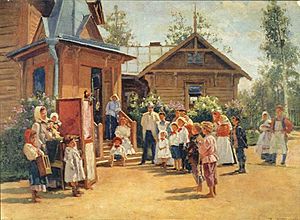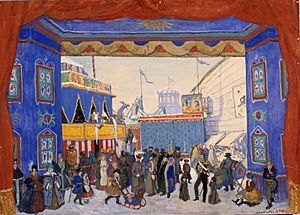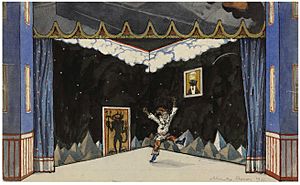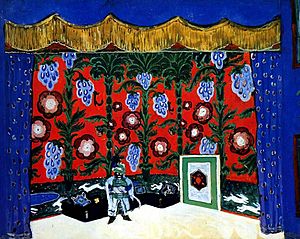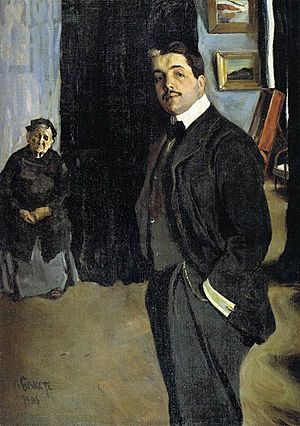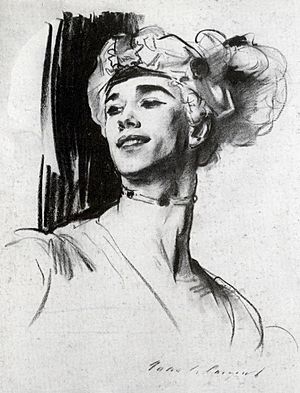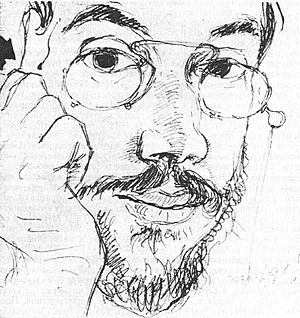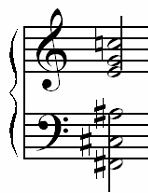Petrushka facts for kids
Quick facts for kids Petrushka |
|
|---|---|
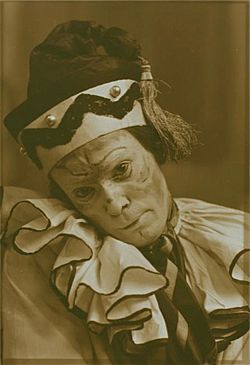
Nijinsky as Petrushka
|
|
| Choreographed by | Mikhail Fokine |
| Composed by | Igor Stravinsky |
| Libretto by | Igor Stravinsky Alexandre Benois |
| Based on | Russian folk material |
| Date of premiere | 13 June 1911 |
| Place of premiere | Théâtre du Chatelet Paris |
| Original ballet company | Ballets Russes |
| Characters | Petrushka The Ballerina The Moor The Charlatan |
| Designs by | Alexandre Benois |
| Setting | Admiralty Square St. Petersburg Shrovetide, 1830 |
| Created for | Nijinsky |
| Genre | Ballet burlesque |
Petrushka is a famous ballet that tells a fun, slightly silly story. It's like a play with dancing and music. Alexandre Benois and Igor Stravinsky created the story. Stravinsky also wrote the music. Michel Fokine designed the dances, which is called choreography. Benois also designed the stage sets and costumes.
Petrushka was first performed by a famous dance company called Ballets Russes in Paris on June 13, 1911. Vaslav Nijinsky played the main character, Petrushka. Tamara Karsavina was The Ballerina. Alexandre Orlov played The Moor, and Enrico Cecchetti was The Charlatan.
The ballet tells the story of three puppets who come to life. They are Petrushka, The Ballerina, and The Moor. A magician called The Charlatan brings them to life at a big fair in St. Petersburg, Russia, in 1830. Petrushka is in love with The Ballerina. But she likes The Moor instead. Petrushka gets very sad and angry. He challenges The Moor, who then kills him with a sword. As night falls, Petrushka's ghost appears above the puppet theater. He shakes his fist at The Charlatan, then disappears.
Petrushka is special because it brings music, dance, and stage design together perfectly. It's one of the most loved ballets from the Ballets Russes. Even today, it's usually performed with the original designs and dances.
Contents
- Russian Puppets: Who is Petrushka?
- The Story of Petrushka
- The Ballets Russes and Sergei Diaghilev
- How Petrushka Was Created
- Music by Igor Stravinsky
- Scenery and Costumes
- Choreography by Mikhail Fokine
- Vaslav Nijinsky: The First Petrushka
- Performance History
- Structure of the Ballet
- Images for kids
- See also
Russian Puppets: Who is Petrushka?
Petrushka is a type of puppet. He is known in many countries, but with different names. In England, he's Punch. In France, he's Polichinelle. In Italy, he's Pulcinella. And in Russia, he's Petrushka! No matter the name, he's usually a mischievous character. He often uses a stick to make things right and speaks in a funny, high-pitched voice.
In the 1700s, fancy string puppets called marionettes came to Russia. These were mostly for rich people. Rod puppets, which came from Asia, were used for religious plays. But Petrushka was a hand puppet. He was very popular with everyday people. He performed in street shows, often in small, easy-to-move booths. After the Russian Revolution, the government made Petrushka perform indoors. They wanted to keep an eye on him because he was a bit of a rebel!
The Story of Petrushka
Scene One: The Shrovetide Fair
The story begins at a lively fair in St. Petersburg in 1830. It's called the Shrovetide Fair, a big celebration before Lent. Many people are there: farmers, police, gypsies, and more. Everyone is looking for fun. Dancers entertain the crowd.
At the back of the stage is a puppet booth. Two toy soldiers beat drums to get everyone's attention. Then, The Charlatan, a magician, appears. The curtain of the booth opens. Inside, there are three puppets, each in their own small space. There's a dark-skinned Moor, a pretty Ballerina, and Petrushka.
The three puppets come out to perform a show. Both The Moor and Petrushka are in love with The Ballerina. But she prefers The Moor. Petrushka gets very jealous and starts a fight. The Charlatan quickly stops the show, and the curtain closes.
Scene Two: Petrushka's Room
The music starts with drumrolls. The curtain rises, and a door opens. Petrushka is kicked through the door and falls. He slowly gets up, making jerky movements. He shakes his fist at a picture of The Charlatan on the wall. The music sounds angry and powerful.
Petrushka falls to his knees. The music becomes softer as he shows how sad he is. He mimes his love for The Ballerina and his dislike for The Charlatan.
The Ballerina enters, dancing on her toes. When Petrushka sees her, he starts to move wildly, with quick jumps. The Ballerina gets scared and quickly leaves. Petrushka falls to the floor, feeling hopeless. The music seems to make fun of him. He curses The Charlatan. For a moment, Petrushka peeks out of his room at the fair crowd. He collapses again as the music mocks him. A trumpet call signals the end of the scene.
Scene Three: The Moor's Room
Drumrolls are heard as the curtain rises. Petrushka's room was dark, but The Moor's room is bright and colorful. The walls have pictures of palm trees, exotic flowers, and white rabbits.
The Moor is relaxing on a bed, playing with a coconut. He shakes it and hears something inside. He tries to open it with his scimitar (a curved sword) but can't. He thinks the coconut is a god and bows to it.
The door opens, and The Charlatan brings The Ballerina into the room. The Ballerina is attracted to The Moor because he looks handsome. She plays a lively tune on a toy trumpet. The Moor tries to dance with her but isn't very good.
The Moor sits on the daybed, and The Ballerina sits on his lap. They cuddle. Suddenly, they hear noises outside. Petrushka has broken out of his room! He rushes in to save The Ballerina. Petrushka attacks The Moor, but he quickly realizes he is too small and weak. The Moor beats Petrushka. Petrushka runs away, with The Moor chasing him. The curtain falls.
Scene Four: The Shrovetide Fair (Evening)
The scene returns to the Shrovetide Fair. It's evening, and the crowd is still having fun. A dancing bear and organ grinders entertain everyone. Nurses perform a dance.
Suddenly, Petrushka runs out of the puppet booth. The Moor is chasing him! The Moor catches Petrushka and kills him with his scimitar. The crowd is shocked and scared. The Charlatan comes out. He shows the crowd that Petrushka is just a puppet filled with straw. The crowd slowly leaves, still surprised by what they saw.
The Charlatan is left alone. Then, the spirit of Petrushka appears on the roof of the puppet booth. He shakes his fist at The Charlatan. The Charlatan is terrified and quickly runs away. Petrushka's ghost collapses over the roof, his arms swinging in the night.
The Ballets Russes and Sergei Diaghilev
Serge Diaghilev was the person who brought together the three men who created Petrushka. He was born into a noble family and studied law. But he loved art and music. He even took music lessons from a famous composer, Nikolai Rimsky-Korsakov.
Diaghilev used his family money to travel and visit art museums in Europe. He also started an art magazine called The World of Art, which was very important in Russia. He later worked at the Imperial Ballet but was fired. Then, he started organizing concerts of Russian music in Paris. He promoted Russian operas and short ballets, and the Paris audience loved them!
In 1910, Diaghilev decided to focus on ballet. He formed the Ballets Russes dance company. Stravinsky's The Firebird was a big success for them in 1910. Even though the company was popular, it didn't have a permanent home. The dancers would go back to their regular jobs after the Paris season ended.
When Vaslav Nijinsky was fired from the Imperial Ballet, Diaghilev hired him. Nijinsky was an amazing dancer. He helped the Ballets Russes become very famous around the world.
Other artists joined the Ballets Russes, but the company still traveled a lot. Petrushka and Le Spectre de la rose were big hits in 1911. Later, The Rite of Spring was a famous ballet in 1913. Nijinsky got married in 1913 and left Diaghilev's company.
In later years, Diaghilev convinced artists like Fokine and Benois to return. In 1921, the company finally found a permanent home in Monte Carlo. They kept creating colorful ballets and became even more famous.
How Petrushka Was Created
Petrushka was created by four main people: the composer Igor Stravinsky, the designer Alexandre Benois, the choreographer Mikhail Fokine, and the Ballets Russes leader Serge Diaghilev. They all worked very closely together.
Stravinsky had the first idea for a ballet about a puppet. But the detailed story, called the libretto, was mostly written by Benois. Benois loved the subject of puppets, and he was good at writing ballet stories.
Alexandre Benois was born in 1870 in St. Petersburg. His father was an architect. Benois didn't plan to be an artist, but he studied law. Later, his artwork was noticed by Diaghilev. Benois started working for the Ballets Russes in Paris.
At first, Benois had left the Ballets Russes because he was upset. But when he heard the new ballet was about Petrushka, he decided to come back. Diaghilev was happy to have him. Diaghilev suggested setting the ballet at the Shrovetide Fair in St. Petersburg around 1830. This time period was one of Benois's favorites. Benois gave Petrushka two puppet friends: The Ballerina and The Moor. He even started designing costumes and sets while the story was still being written. This helped everyone imagine how the ballet would look.
The team met in Rome in 1911. Even though the music and story weren't finished, rehearsals for Petrushka had already started. The ballet really took shape when Fokine began teaching the main dancers and the crowd scenes.
Music by Igor Stravinsky
Igor Stravinsky was born in 1882 near St. Petersburg. His father was an opera singer. As a boy, Stravinsky learned piano and music theory. He later studied law but spent most of his time on music. In 1905, he began studying music with Nikolai Rimsky-Korsakov.
In 1909, Diaghilev heard some of Stravinsky's music and was very impressed. In 1910, Diaghilev needed music for a new ballet called The Firebird. After some other composers didn't work out, Diaghilev chose Stravinsky. Stravinsky was young and didn't have much experience, but he accepted the job. He was honored to be chosen to work with such talented people.
Stravinsky worked closely with Fokine on The Firebird. They made sure the movement, music, and design all fit together perfectly. The ballet was a huge success in 1910.
This success led Diaghilev to ask Stravinsky to write music for another ballet, The Rite of Spring. Stravinsky had the idea for this ballet from a dream. It was a big project, and he got tired of it. So, he started working on a shorter piece for piano and orchestra to refresh himself. He imagined this new piece as a contest between the orchestra and the piano. The orchestra would win in the end.
Stravinsky was thinking of the Russian hand puppet, Petrushka, when he wrote this piano piece. He said he pictured "a puppet, suddenly endowed with life, exasperating the patience of the orchestra." The orchestra would then "retaliate with menacing trumpet blasts."
The music for Petrushka is very modern. It uses old folk tunes and popular songs but changes them in new ways. The most modern music is in Scene Two. This is the music Stravinsky wrote as his piano concert piece. The scene starts with two different musical keys played at the same time. This represents Petrushka being both a living creature and a straw puppet.
Stravinsky also used some popular Russian folk tunes. He even included a waltz by an old Viennese composer for The Ballerina and The Moor in Scene Three. He also used a popular French song in Scene One.
Stravinsky changed the Petrushka music several times over the years. He made a shorter version for concerts. He also created a difficult piano version for a famous pianist.
Scenery and Costumes
The ballet is set at the Shrovetide Fair in St. Petersburg in 1830. Benois had many childhood memories of these fairs. He put all those fun details—the sideshows, small theaters, and rides—into the first and fourth scenes of Petrushka.
Benois designed Petrushka eleven times over the years. His designs were always based on the very first show in 1911. He always set the ballet in Admiralty Square, even though the real fair moved to other places.
All of Benois's Petrushka designs had some things in common. They all had a stage frame in a Russian folk style. The backdrop usually showed St. Isaac's Cathedral. The costumes were very accurate to what people wore in the 1830s. A special curtain would come down between scenes, showing The Charlatan surrounded by clouds.
The second scene shows Petrushka's small, lonely room. There's a picture of The Charlatan on the wall. The original picture was damaged, and a new one was used that Benois didn't like. He was so upset he didn't speak to Diaghilev for a long time!
The third scene is The Moor's room. This scene was difficult for Benois to design. He tried many jungle animals on the walls, like elephants and lions, but wasn't happy. Finally, he chose palm trees. This exotic design stayed the same in all his later productions. It made a strong contrast to Petrushka's plain room.
Choreography by Mikhail Fokine
Mikhail Fokine was born in 1880 and started at the Imperial Ballet school in 1889. He became a dancer there in 1898. He was very smart and ambitious. In 1902, he started creating short ballets for students.
Fokine didn't like many old ballet traditions. He wanted every dance movement to have meaning. He wanted ballets to flow smoothly from start to finish, not stop and start like older ballets. He also wanted dancers to show the music's feelings through their movements. He wrote down five main ideas for his new style of dance.
He used his ideas in his ballets and had great success. He respected old ballets but preferred to create new ones. In 1907, he choreographed Le Pavilion d'Armide, working with Benois for the first time. This ballet was well-received.
Benois introduced Fokine to Diaghilev. Fokine choreographed several ballets for Diaghilev's company, including Les Sylphides and The Firebird. In 1911, he choreographed Petrushka.
Fokine said Stravinsky's music for Petrushka was "tormenting the ear and yet stimulating the imagination." The dancers found the music hard to count. But Fokine still managed to create the dances. He changed ballet forever with this work.
In Petrushka, Fokine gave The Ballerina quick, pointed steps. The Moor's toes were turned out, while Petrushka's toes were turned in. The puppets' stiff, mechanical movements were a contrast to the natural movements of the crowd. The mime (acting without words) showed The Ballerina's vanity, The Moor's pride, and Petrushka's helplessness.
Fokine might have been influenced by other ballets about dolls that come to life, like Coppélia. In Petrushka, Fokine made a big change: he turned the main star roles into character roles. He also removed some traditional parts of classical ballet, like long introductions and special dances just for the stars. The solo parts for The Moor and Petrushka are mostly mime. The Ballerina doesn't even have her own solo scene.
Fokine used bits of Russian folk dances for the crowd characters. Some people complained that the crowd wasn't rehearsed enough, or that Diaghilev didn't spend enough money on certain effects.
Vaslav Nijinsky: The First Petrushka
Vaslav Nijinsky was born in Russia around 1889. His parents were Polish dancers. He went to the Imperial Ballet school and became a great dancer. He danced with famous ballerinas like Anna Pavlov and Tamara Karsavina. He met Serge Diaghilev, and later joined Diaghilev's Ballets Russes.
Nijinsky was famous for truly becoming the character he played. He could change his looks and amazing dance skills into a very moving performance. He made Petrushka a sad puppet with jerky, awkward movements.
At first, Nijinsky found it hard to understand Petrushka during rehearsals. He asked Benois for help. But on the night of the show, Nijinsky completely transformed into the puppet. Benois wrote that Nijinsky was brave to play such a "horrible half-doll, half-human grotesque" after being a handsome lead dancer. The hardest part of Petrushka's role was to show his sadness and his wish to be a real person, while still looking like a puppet.
An American dance critic, Carl Van Vechten, described Nijinsky's Petrushka: "He is a puppet and — remarkable touch — a puppet with a soul." He said Nijinsky's performance was amazing because he only moved like a puppet, and his face never changed. Yet, he showed so much sadness. Van Vechten remembered Nijinsky as Petrushka, "mad with love for the dancer... rushing about waving his pathetically stiff arms in the air, and finally beating his way with his clenched fists through the paper window to curse the stars." He said it was a more powerful way to show grief than many actors could manage.
Performance History
Petrushka was first performed by the Ballets Russes in Paris at the Théâtre du Châtelet on June 13, 1911. Nijinsky was Petrushka, Tamara Karsavina was The Ballerina, Alexandre Orlov was The Moor, and Enrico Cecchetti was The Charlatan. Pierre Monteux conducted the music.
Fokine brought the ballet back to the stage in 1925 for the Royal Danish Ballet. He also revived it for Ballet Theatre in October 1942. The Royal Ballet performed it again on March 26, 1957. Rudolph Nureyev danced Petrushka with the Royal Ballet in 1963.
The ballet was first performed in the United States by the Ballets Russes in New York City on January 25, 1916. Leonide Massine played Petrushka. The Joffrey Ballet brought the work back in New York City in 1970, and the American Ballet Theater also revived it that same year.
Structure of the Ballet
Tableau I: The Shrovetide Fair
- Introduction
- Drunken Revelers dance by.
- The Master of Ceremonies entertains the crowd.
- An Organ-Grinder and a Dancer appear.
- The Organ-Grinder plays, and the Dancer performs.
- Another Music Box plays with another Dancer.
- The music stops, and the Master of Ceremonies continues his show.
- The Merry Group returns.
- Two Drummers get the crowd's attention.
- The Old Magician appears from the Little Theater.
- The Magic Trick
- The Magician plays the flute.
- The curtain opens, showing three puppets: Petrushka, a Moor, and a Ballerina.
- The Magician brings them to life with his flute.
- Russian Dance
- Petrushka, the Moor, and the Ballerina suddenly start dancing, surprising the crowd.
- Darkness, curtain falls.
Tableau II: Petrushka's Room
- The door to Petrushka's room opens, and he is kicked onto the stage.
- Petrushka is angry.
- The Ballerina enters.
- The Ballerina leaves.
- Petrushka is sad and hopeless.
- Darkness. Curtain.
Tableau III: The Moor's Room
- Introduction
- The Moor dances.
- The Ballerina appears.
- Dance of the Ballerina (with a small trumpet).
- Waltz (The Ballerina and the Moor dance together).
- The Moor and the Ballerina hear noises.
- Petrushka appears.
- The Fight between the Moor and Petrushka. The Ballerina faints.
- The Moor throws Petrushka out. Darkness. Curtain.
Tableau IV: The Shrovetide Fair (Toward Evening)
- Introduction
- The Wet-Nurses' Dance
- A Peasant enters with a Bear, making everyone scatter.
- The Peasant plays a pipe, and the Bear walks on its hind legs.
- The Peasant and Bear leave.
- Jovial Merchant and Gypsy Girls
- A happy Merchant and two Gypsy Women enter. He throws money to the crowd.
- The Gypsy Women dance. The Merchant plays an accordion.
- The Merchant and Gypsies leave.
- Dance of the Coachmen and the Grooms
- The Wet-Nurses dance with the Coachmen and Grooms.
- The Masqueraders
- A person dressed as the Devil makes the crowd play.
- Funny acts by the Masqueraders.
- The Masqueraders and other masked people dance.
- The rest of the crowd joins the dance.
- The Scuffle
- The crowd keeps dancing, not noticing cries from the Little Theater.
- The dances stop. Petrushka runs from the Little Theater, chased by the Moor. The Ballerina tries to stop the Moor.
- The angry Moor catches Petrushka and hits him with his sword.
- Petrushka falls, his head broken.
- Death of Petrushka
- A crowd gathers around Petrushka.
- He dies, still making sounds.
- A Policeman goes to find the Magician.
- The Magician arrives.
- He picks up Petrushka's body and shakes it.
- The crowd leaves.
- The Magician is left alone. He drags Petrushka's body towards the Little Theater.
- Above the Little Theater, the Ghost of Petrushka appears. He looks threatening and makes a rude gesture at the Magician.
- The terrified Magician drops the puppet Petrushka and quickly leaves, looking back nervously.
- Curtain.
Images for kids
-
Tombstone of Vaslav Nijinsky in Montmartre Cemetery in Paris. The statue shows Nijinsky as the puppet Petrushka.
See also
 In Spanish: Petrushka (personaje) para niños
In Spanish: Petrushka (personaje) para niños


